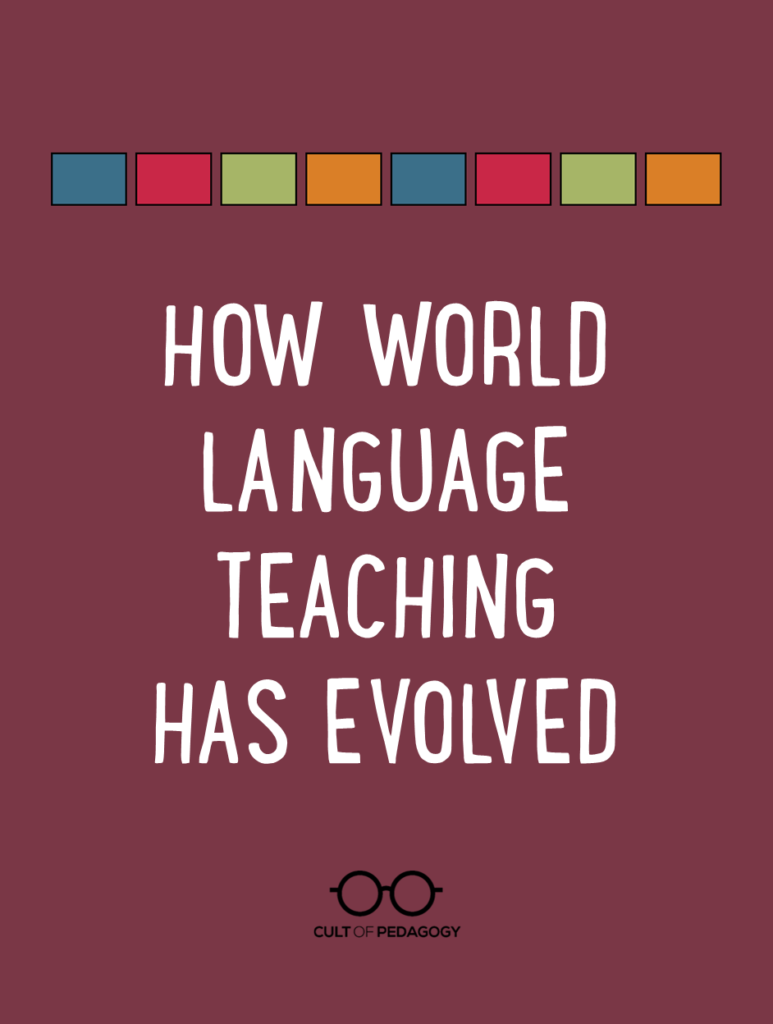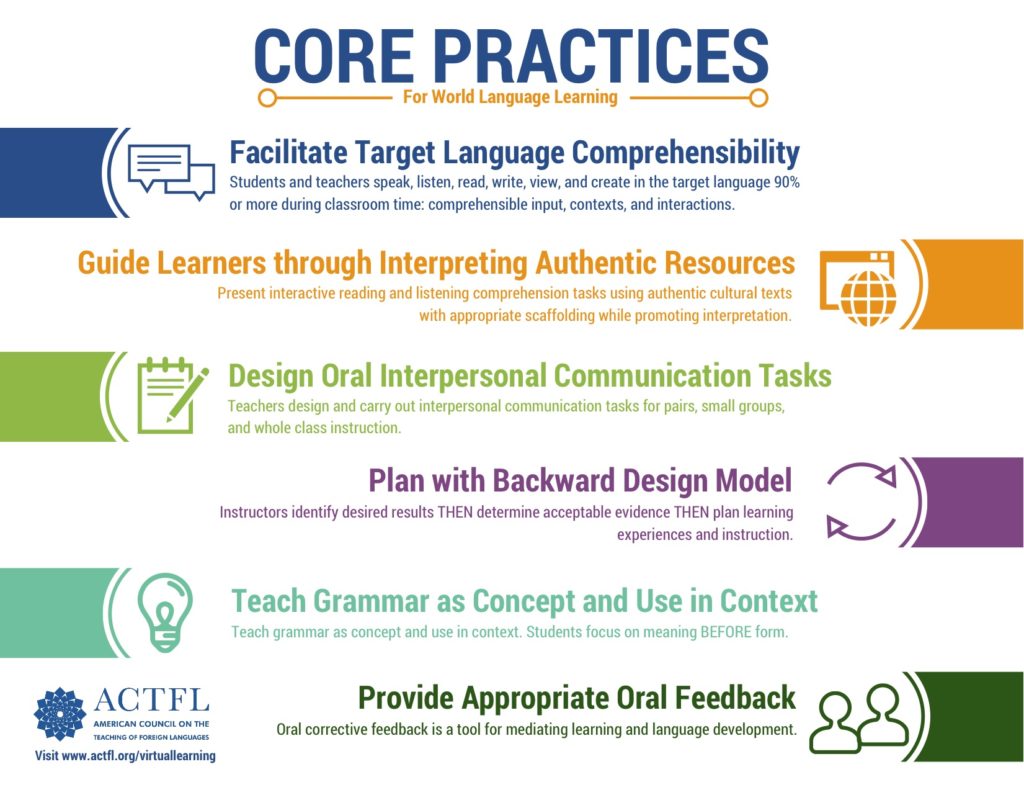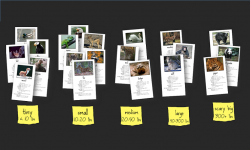
Listen to my interview with Rebecca Blouwolff (transcript):
Sponsored by Public Consulting Group and ViewSonic
“I took French for three years, but I can’t speak any French.” Some version of this is expressed by so many of us who took a language class in school. The lack of connection between school-based language classes and actually learning how to speak that language seems to be something we’ve just accepted.
This is probably due to the way languages have traditionally been taught: Lots of vocabulary and book work, verb conjugations, occasional bite-sized “culture” studies, and scripted dialogues that don’t give students much real-life practice using the language in real situations.
But if you stopped by a world language class today, you might be surprised to find that a lot of those traditional practices are disappearing: Textbooks are being replaced with more authentic resources, culture is integrated in a more organic way across all activities, and there’s a much bigger emphasis on helping kids learn to actually communicate in the whole language, rather than just master parts of it.
I first became aware of these shifts when I met Rebecca Blouwolff, a French teacher in Boston who interviewed me for the We Teach Languages podcast this past spring. Getting to know Rebecca, I could see how excited she was about some of the changes she’d made to her practice in recent years, and she mentioned how different things were getting across the board in the world language teaching community.

So naturally I wanted to know more. In our podcast interview, which you can listen to above, Rebecca shares six of the most significant changes she has made to the way she teaches her own French class, changes that reflect a growing trend among world language teachers across the board.
If you want a more comprehensive look at all the shifts in world language instruction, two documents from the American Council on the Teaching of Foreign Languages (ACTFL) will help to flesh out the thinking behind the changes:
- The Six Core Practices for language learning recommended by the ACTFL
- A Skills Map for world language learning produced by the ACTFL in collaboration with the Partnership for 21st Century Skills
Six Shifts in World Language Teaching
1. Students learn to USE the language instead of learning ABOUT the language
It used to be that world language teachers could opt to use English for most of their instructional communication and only use the new language for structured lessons or activities. Although there have always been language teachers who insisted on speaking as much of the new language as possible, many other teachers tended to isolate the new language to structured lessons without really requiring students to use the language to communicate throughout a class period.
But now all world language teachers are encouraged to use the new language much more: The ACTFL recommends that teachers and students use the new language for 90 percent of class time. The rationale is that regular use of the language will result in greater fluency and proficiency in day-to-day communication.
“No one is signing up for my class because they’ve always dreamt of learning the subjunctive, right?” Blouwolff says. “I think everyone who takes a language class wants to talk to people in the language, but we had not been delivering on that promise in previous generations.”
This doesn’t mean the teacher simply barrels ahead with the new language in a way that students have no chance of understanding.
“It can’t just be that I get up there and yap on in French and maybe the kids are listening and maybe they’re not,” Blouwolff explains. “It has to be what we call comprehensible input. I’m providing meaningful messages in a way that they can digest them, and I am designing lessons so that I’m getting tons of feedback on which parts they’re able to process and understand. I’m scaffolding for them so that from the very first days, they know enough French to be able to respond to me either nonverbally or with very, very simple words.”
2. Communicative activities are given priority
Whereas the speaking that happened in language classes of the past was often highly structured, focusing mainly on getting the correct answer to a set of exercises, more emphasis is now being given to activities that require students to actively communicate with each other.
This shift begins with the way the teacher interacts with students.
“So often as teachers,” Blouwolff says, “our talk with students is evaluative in nature. Teacher asks a question, student gives an answer, and then the teacher says something like, Good job, yes! “
To create a language speaking community, she says, “we really need to quell the desire to give that evaluative answer and try to be more interactive, like, Oh really? Tell me more about that. You’re going to the movies this weekend? Are you going to go to this movie theater? This shows that we’re curious about what our students have to say, so we’re encouraging them to keep talking in the language.”
Along the same lines, discussion activities are also changing to require more active, relevant communication between students.
For example, instead of having students talk about what they did over the weekend, Blouwolff might say, “Talk to your partner about their weekend until you found two things that you both did and two things that were different. And then I might say, having done that, decide who had the more physically active weekend.” In this way, students are not just listing activities for an exercise; they’re having a conversation about something that might be more inherently interesting to them.
3. Grammar is taught in the context of other meaningful activities
“In the past,” Blouwolff says, “I think we had this idea that we had to give students all the rules before they were allowed to create with language at all. So don’t even think about the past tense until you know all six forms this way and that way.”
Now with the larger emphasis on functional communication, “We’re really backing up and saying, what do we need students to be able to do? In order to do that specific task, what grammar would they need? What language would they need?”
So rather than teaching grammar in isolation, with students completing dozens of conjugations, concepts are taught in small chunks as needed to meet a particular communication goal.
“When we present those chunks as vocabulary and not as tricky grammar,” Blouwolff says, “the kids are able to use it right away. Even my first-year French students can say, ‘I went,’ and if I give them that, they can tell me all the places they went over the weekend. But if you were to look at a traditional textbook, absolutely no way would students be allowed to form a past tense irregular verb in the first year. That’s just not going to happen.”
“I think the fact that we don’t tell them it’s tricky grammar makes it go down a lot easier. The focus now is really on, do you know enough so that you can convey a message, and who would understand your message? Depending on how accurate you are, maybe only another world language teacher can understand your French right now. Maybe next year you’ll be able to be understood by a patient native speaker who’s accustomed to non-natives. And then the goal would be someday you could stop a busy person on the streets of Paris, and they would listen to you.
“But we’re not aiming there right away. If we insist on perfection from the get-go, most people just drop out, because that’s not how we’re built to communicate.”

4. Students examine authentic cultural resources
“For far too long,” Blouwolff says, “culture was relegated to these little blurbs in the textbook chapters, and if you had extra time you would read them and sometimes they were really awful. Or maybe some teachers were doing a thing like culture Fridays.”
In place of these activities, she says, “We’re using audio and text that were created by and for native speakers. So these are not materials for language learners: things like children’s books, YouTube videos, finger plays, pop songs, advertisements, tweets. The textbook really is not the curriculum anymore, and when we take these authentic resources and start using them at the center of our courses, then culture becomes the curriculum. But it just happens to be taught, for example, in French.”
For this approach to work, teachers need to select these materials with care. “We do have to be very intentional about the texts we choose, making sure that they’re appropriate for the level of our learners, that there’s tons of visual support, that the way they’re laid out really makes it clear what’s going on. And then we can create tasks that are appropriate.”
One activity Blouwolff did with her students was watching real estate videos in French. While watching, students are likely to notice some cultural differences, like the fact that homes in France keep the toilet in a separate room from the rest of the bathroom.
“They will initially often have a yuck factor,” she says, “like That’s so gross. How can the sink not be with the toilet? So we can try to take some of that judgment off of it by looking at it as a cultural product and then thinking about, okay, what’s the practice? What is the thing going on in this culture that makes this practice make sense? And it’s just a different way of looking at it.”
5. Instruction is planned using backward design
Just as in so many other subject areas, language teachers have traditionally followed the lead of their textbooks to plan instruction: They follow the book’s path through a series of exercises, then create and deliver some sort of assessment (or use one provided by the textbook company) when the exercises are done.
Although this approach allows teachers to cover a lot of content, the priority is exactly that: coverage, rather than real transfer of knowledge. This is another likely explanation for why so many students leave language classes without knowing how to speak the language.
“For so many years I felt that I was a necessary prisoner of my textbook, and that was my curriculum. The textbooks I have seen for world language cover a ridiculous amount of vocabulary and grammar, and maybe that sells more books because you get so much for your buck, but it’s totally unrealistic in terms of what kids are going to retain.”
When language teachers shift to planning with backward design—where they start by developing an assessment for a clear, measurable outcome, then plan lessons to enable students to succeed on that assessment—they keep the focus on goals for real communication.
“It’s so important that we start with the end in mind,” Blouwolff says. “What do we want our students to be able to do at the end of a unit? What do we hope our students will be able to write at the end of this unit? What do we hope they will be able to talk about? What would that sound like with their language level?”
Blouwolff heightens the impact of this kind of planning by sharing these goals with students at the beginning of each unit. For example, “At the end of this unit,” she’ll tell them, “I’m going to ask you, tell me about your town and then compare it to Quebec City. So there’s no stress at the end. Everyone knows. But there’s also some motivation. Like, how close am I getting to be able to do that? Why is she talking about this? Oh right, because at the end of the unit, we have to be able to XYZ.”
Keeping the end goal transparent not only boosts motivation for students. “It’s super exciting for the teachers,” Blouwolff says, “because they’re like, OK, let’s see how we can get there, what’s going to happen, you know? There is that discovery moment at the end that’s very different than correcting your publisher written unit exam.”
6. Teachers regularly provide appropriate feedback
In the past, assessment meant measuring what students can’t do. Now language teachers are trying to put more focus on the progress students are making.
“We’re absolutely not marking every error and all the more so when they’re speaking; we’re not going to interrupt students speaking to let them know that they said this or that wrong,” Blouwolff explains. “Number one, it’ll just shut them down. Number two, they’re never going to remember the correction and reuse it in all likelihood. They’re too busy thinking of what they’re going to try to say.
“So I think what teachers can do is look for patterns of error and think about giving maybe one or two pieces of feedback to students on their work. I really like that model of glow and grow: Here’s something that you did really well, here’s an area where you could improve.”
To help teachers get a sense for what students should be capable of at each stage of language learning, ACTFL has defined proficiency levels students go through as they progress in their language development. Blouwolff appreciates having these targets on hand. “I know, for example, in French 7, I need to get my kids to what we call a Novice High. And that level has very particular characteristics that I want my students to know and understand in a really deep way, so that they know what they need to do to reach that level and then even to surpass it.”
Other frameworks like Shrum and Glisan’s T.A.L.K. rubric measure qualities beyond language proficiency, like whether students are cooperative with other group members in a discussion. Including factors like these in assessment and feedback furthers the big-picture emphasis on quality communication.
“Years ago,” Blouwolff says, “I was having kids recite skits where it literally did not matter what the other person said, because you’d memorized your half, and you were reciting that no matter what happened. This is much more like what they’re working towards: talking to people in another language.”
You can find Rebecca Blouwolff on Twitter at @MmeBlouwolff or on her blog at mmeblouwolff.weebly.com.
Join our mailing list and get weekly tips, tools, and inspiration that will make your teaching more effective and fun. You’ll get access to our members-only library of free downloads, including 20 Ways to Cut Your Grading Time in Half, the e-booklet that has helped thousands of teachers save time on grading. Over 50,000 teachers have already joined—come on in.





Hi Jennifer, I was excited to see that you were doing a session on world language teaching, but a little disappointed to see the agenda. The ACTFL inspired changes to language classroom pedagogy are about 15 years behind the forefront of the language teaching evolution. They are all good developments to help teachers get away from the grammar-based syllabus and textbook, but the language teaching revolution that has brought the greatest changes is generally called these days teaching with comprehensible input, abbreviated to CI by teacher practitioners. ACTFL has only recently begun to recognize the CI movement by finally creating a Special Interest Group a year ago. Better places to meet the new world of language teaching are Facebook Groups and websites with CI, TPRS, NTPRS, or IFLT in their names, the ACTFL-published book by Bill VanPatten, While We’re on the Topic, and the Bill VanPatten podcast, Talkin’ L2 with BVP. Thanks for listening, Richard Detwiler
I second that. Very well put Richard.
To be fair, ACTFL was never in the business of prescribing pedagogy at such a detailed level. In fact, the 90% plus target language recommendation is written very carefully. It is not some edict given out by the emperor. We are professionals. Every classroom context and every student is different. Like Stephen Krashen, Tracy Terrell and others were trying to say is that we language learners acquired language in spite of our language teachers many times. It is not that exact of a science yet. It seems to me that a lot of the literature or manuals that TPRS-CI had out were cumbersome or were not easy to realize if one is not an animated, energetic instructor.
ACTFL has been a conduit for bringing all of the language associations and factions together. It helped jettison proficiency-based instruction by attaining a grant to adapt the FSI-ILRT proficiency levels to academia. Even in those documents, it warns not to use the levels as pedagogy. Languages aren’t acquired in such a vertical, linear, lock-step way. There is more ebb and flow to it and it is too complex to know. There is no chicken or egg story here. Only a profession that is half science and half art. Still in its infancy.
Forgive me for chiming in again. It seems we are also forgetting the history and evolution of a lot of people. ACTFL has been instrumental in acknowledging the work of Vygotsky, Glisan, Donato, Valdes and others that we take for granted. The sociocultural approach to language learning is at the heart of TPRS/CI whatever you want to call it. However, the Zone of Proximal Development is not Comprehensible Input or C+1.
For that reason, I believe many people stayed clear of TPRS approaches because it seemed behind the current knowledge of language acquisition.
I’m aware I just opened up a can of contention but like I alluded to earlier, the world language profession has not existed in a vacuum. Many language instructors like myself have degrees and certifications in linguistics or TESOL or bilingual education. We have all learned from each other over the years in fits and starts. It’s not so cut and dried. I’ve been at this since 1986 and we have made leaps and bounds over the past ten years–mostly due to ACTFL’s generosity and vision.
You may have been in too much of a hurry to promote your friend’s blog, but in section 1, last paragraph she says:
“It can’t just be that I get up there and yap on in French and maybe the kids are listening and maybe they’re not,” Blouwolff explains. “It has to be what we call comprehensible input. I’m providing meaningful messages in a way that they can digest them, and I am designing lessons so that I’m getting tons of feedback on which parts they’re able to process and understand.”
if ACTFL is 15 years behind is the book they published more up to date?
Thanks for the heads up, I will check out your friend’s website. I am just getting starting in Teaching English and have everything to learn.
Hello Jennifer,
While I was reading your post, I was struck by the fact that language teaching in France is stuck in the ACTFL mode till date… and we don’t see it moving out for another 10 years at least. The reason for this slow change is the bureaucracy in the school system and outside too! That’s cultural here, where change is resisted till it’s forced down their throats like gavage for the geese i.e. for foie gras!
Changes are coming but very slowly…
Thanks for reading this.
Kavita Gursahani
I am reading this as a science teacher with the next generation of science standards forefront in my mind. I shift French language to the language of science, and using enough to get the students able to communicate about the topic instead of a complete list of all vocabulary words in that topic. Then, get the students to talk in depth with followup for even deeper speaking (and writing) so that they practice using the new language acquired. This is very useful.
John,
Thank you for sharing this. We love it when readers are able to take the posts and apply them to their context. I’m sure someone else who comes across your thinking will also find this valuable. Thanks again for sharing!
I, too, agree with Richard. The innovation over the last 25 years has mostly taken place outside of ACTFL with the latter playing catch up.
As for AP, TPRS/CI students have above average pass rates with skilled teachers and it stands to reason as the test shifted away from an antiquated grammar driven syllabus to one that values interpretation and communication.
With all due respect, that is not a fair statement. ACTFL is not a monolith. It is over 12, 000 members from all aspects of the language learning profession. ACTFL serves as a conduit for those groups that have a clear mission and message. The TPRS/CI movements have not always seemed accessible or clear at times. I have struggled for years with some aspects of it, knowing what we know about the socialcultural aspect of language acquisition and the ZPD. Please read my comments above.
I wonder where these changes are happening. The high school where I teach does not teach this way. Long list of vocab. Must spell correctly. No room for error. Very difficult. Kids are dropping bc its too hard.
Ver disappointed as a former Spanish teacher… Now ESL teachrr. This is not how language is learned.
The points you mske are great but i am not seeing that. Maybe once you pass the regents but so many drop by then. Its a small group that continue through senior year.
I understand your frustration. I have witnessed and experienced the reality you describe. My experience has shown me that it doeach by example and go slow at first. Keep it light and fun. As Rebecca describes, just copy some of the steps that these input processing or comprehensible input teachers do and soon it will make sense to you.
Slow and steady wins the race. The more the stakeholders have a positive experience with the approach, the easier it gets because they witness the engagement and the results of the efforts.
It certainly keeps students off their cellphones by having to actively contributing to the fun.
Thanks for this post. I only recently came across Rebecca’s amazing blog and she is a true French teacher rock star! Not only does she create amazing lessons but she also shares them via her blog. For those of us who are stuck with a book but supplement heavily, she is a godsend! The TPRS trend mentioned in a previous comment is interesting but hard to implement in a piecemeal way, and it does not necessarily work well at the highest levels, AP and beyond, when you do want students writing in coherent sentences using advanced structures.
Enjoyed the enthusiastic strategies! Thank you!
Thank You for sharing such a nice and informative blog and your knowledge with us. Language teaching for most of the 20th Century was heavily influenced by the ‘grammar-translation’ of the 19th Century, which involved learning a new word or grammatical structure, translating it into your native language and memorizing it.
I am interested as a recently retired person of interesting students of languages on the basis of creative employment. I spent some 20 summers in Italy operating our own programs to the delight of almost 100% of the participants and teachers. I’ve a long story to tell and was awarded handsomely by the town fathers of a place in central Italy. We must entice North Americans away from the growing mono-lingualism we are returning to in the USA by way of manageable and exciting ways to becoming multilingual for one’s career development as well as personal fulfillment. cje
As a language teacher and user I do not see any drastically shift from oral tradition to present oral-written mix tradition of languages using.we need more researches to prove shift or change.This world has wonderful history and tradition of our oral language use.Anyway this is informative.thanks
As a language teacher, I am really happy to hear from all these experiences.
I have some times wondered why some learners can be good writers but fail tom speak or be good speakers but can not write a language down.
I t is really challenging but some of these ideas like putting the language teaching into practice and using appropriate resources can try to solve some of these issues indeed.
Thank you very much for the experiences.
Glad this was helpful, Job!